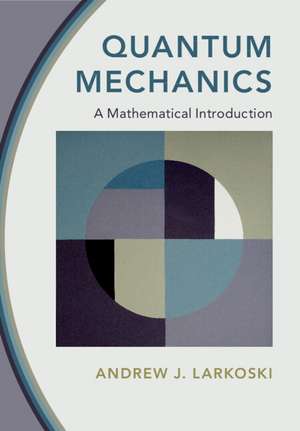Quantum Mechanics: A Mathematical Introduction
Autor Andrew J. Larkoskien Limba Engleză Hardback – 14 dec 2022
Preț: 451.17 lei
Nou
Puncte Express: 677
Preț estimativ în valută:
86.34€ • 93.75$ • 72.53£
86.34€ • 93.75$ • 72.53£
Carte tipărită la comandă
Livrare economică 22 aprilie-06 mai
Preluare comenzi: 021 569.72.76
Specificații
ISBN-13: 9781009100502
ISBN-10: 1009100505
Pagini: 398
Dimensiuni: 183 x 261 x 23 mm
Greutate: 0.9 kg
Editura: Cambridge University Press
Colecția Cambridge University Press
Locul publicării:Cambridge, United Kingdom
ISBN-10: 1009100505
Pagini: 398
Dimensiuni: 183 x 261 x 23 mm
Greutate: 0.9 kg
Editura: Cambridge University Press
Colecția Cambridge University Press
Locul publicării:Cambridge, United Kingdom
Cuprins
1. Introduction; 2. Linear Algebra; 3. Hilbert Space; 4. Axioms of Quantum Mechanics and Their Consequences; 5. Quantum Mechanical Example: The Infinite Square Well; 6. Quantum Mechanical Example: The Harmonic Oscillator; 7. Quantum Mechanical Example: The Free Particle; 8. Rotations in Three Dimensions; 9. The Hydrogen Atom; 10. Approximation Techniques; 11. The Path Integral; 12. The Density Matrix; 13. Why Quantum Mechanics?; Appendix A. Mathematics Review; Appendix B. Poisson Brackets in Classical Mechanics; Appendix C. Fundamental Constants and Units; Appendix D. Quantum Mechanics Jargon Glossary; Appendix E. Bibliography.
Recenzii
'This book is a refreshing and innovative addition to quantum mechanics teaching. It will help students build strong mathematical skills to rely on when studying this novel subject. Larkoski demystifies the subject and provides instructors with new ways to cover even the most canonical examples in quantum mechanics. I think it will also be a very useful companion for students learning quantum field theory.' Seyda Ipek, Carleton University, Ottawa
'Larkoski's book uses an original and innovative approach to introduce (and develop intuition about) the mathematics leading to the axioms of quantum mechanics. Overall, a refreshing introduction to quantum mechanics.' Jean-Sebastien Gagnon, Norwich University, Vermont
'Dr Larkoski starts with a gentle introduction to linear algebra and the Dirac – von Neumann axioms of quantum mechanics. Throughout he stresses the role of the scientific method in which measurable states and observables evolve and predictions of this evolution become tests of the model hypothesis. Dr Larkoski strives to keep differential equations to a minimum by exploiting symmetries and conservation laws through Lie algebra and group properties. Students see standard one-dimensional examples typically encountered in an undergraduate course. The 3D hydrogen Hamiltonian is diagonalized interestingly using angular momentum and Laplace – Runge – Lenz operators. Advanced topics are introduced including perturbation theory, WKB approximation, path integrals, the density matrix, and entanglement.' Russell Herman, University of North Carolina, Wilmington
'Quantum Mechanics by Larkoski is a much-needed update to undergraduate quantum mechanics teaching, and a good introduction to the way physicists think about and use quantum mechanics. Indispensable tools of modern research like the density matrix, s-matrix and Lie algebras are introduced and applied to the analysis of pedagogical systems, elucidating their meaning and functionality. The book is also well written and generally easy to follow, with appropriately placed examples.' Varun Makhija, University of Mary, Washington
'Larkoski's book uses an original and innovative approach to introduce (and develop intuition about) the mathematics leading to the axioms of quantum mechanics. Overall, a refreshing introduction to quantum mechanics.' Jean-Sebastien Gagnon, Norwich University, Vermont
'Dr Larkoski starts with a gentle introduction to linear algebra and the Dirac – von Neumann axioms of quantum mechanics. Throughout he stresses the role of the scientific method in which measurable states and observables evolve and predictions of this evolution become tests of the model hypothesis. Dr Larkoski strives to keep differential equations to a minimum by exploiting symmetries and conservation laws through Lie algebra and group properties. Students see standard one-dimensional examples typically encountered in an undergraduate course. The 3D hydrogen Hamiltonian is diagonalized interestingly using angular momentum and Laplace – Runge – Lenz operators. Advanced topics are introduced including perturbation theory, WKB approximation, path integrals, the density matrix, and entanglement.' Russell Herman, University of North Carolina, Wilmington
'Quantum Mechanics by Larkoski is a much-needed update to undergraduate quantum mechanics teaching, and a good introduction to the way physicists think about and use quantum mechanics. Indispensable tools of modern research like the density matrix, s-matrix and Lie algebras are introduced and applied to the analysis of pedagogical systems, elucidating their meaning and functionality. The book is also well written and generally easy to follow, with appropriately placed examples.' Varun Makhija, University of Mary, Washington
Notă biografică
Descriere
This innovative textbook takes the unique perspective of introducing and solving problems in quantum mechanics using linear algebra methods
